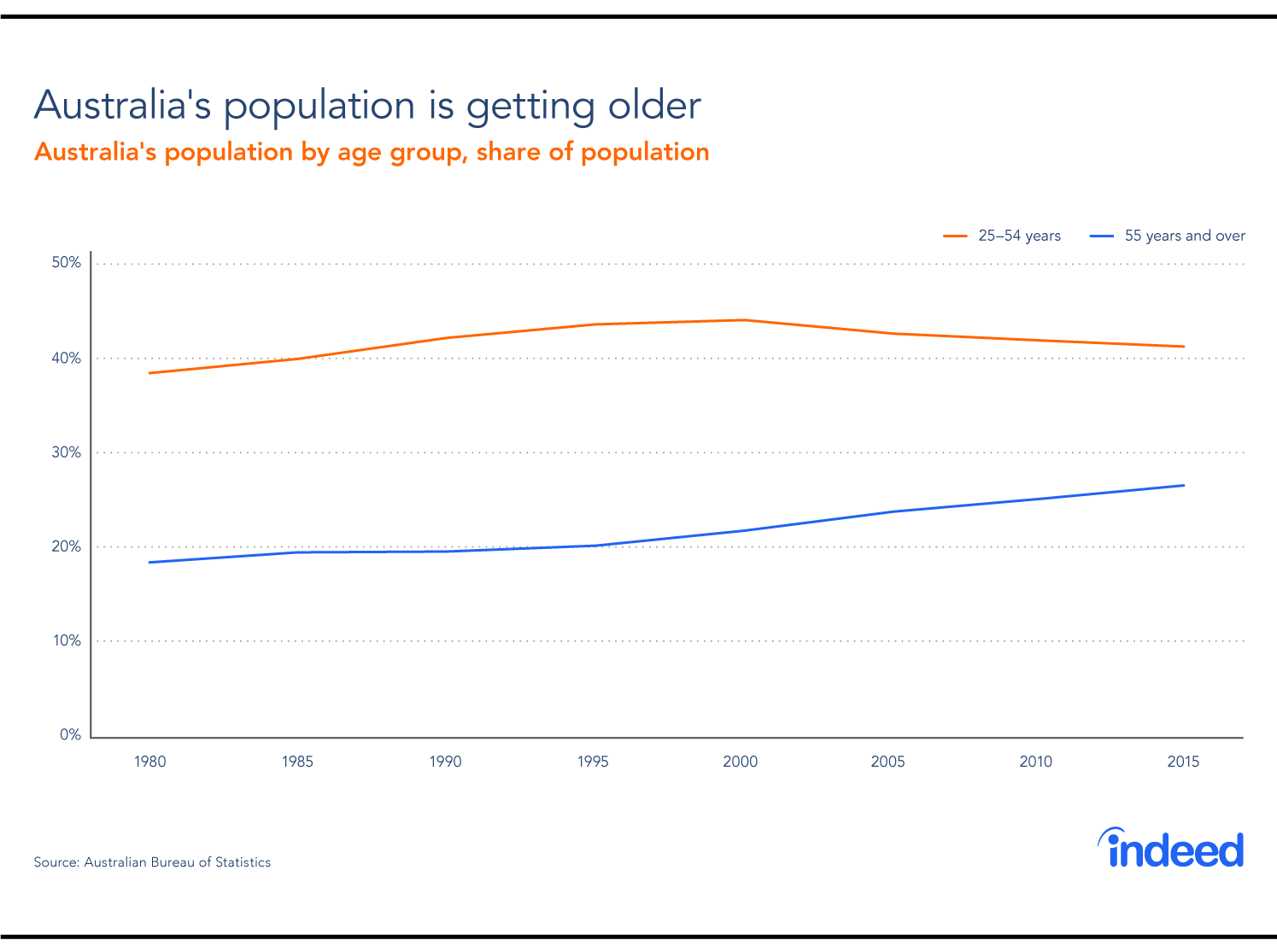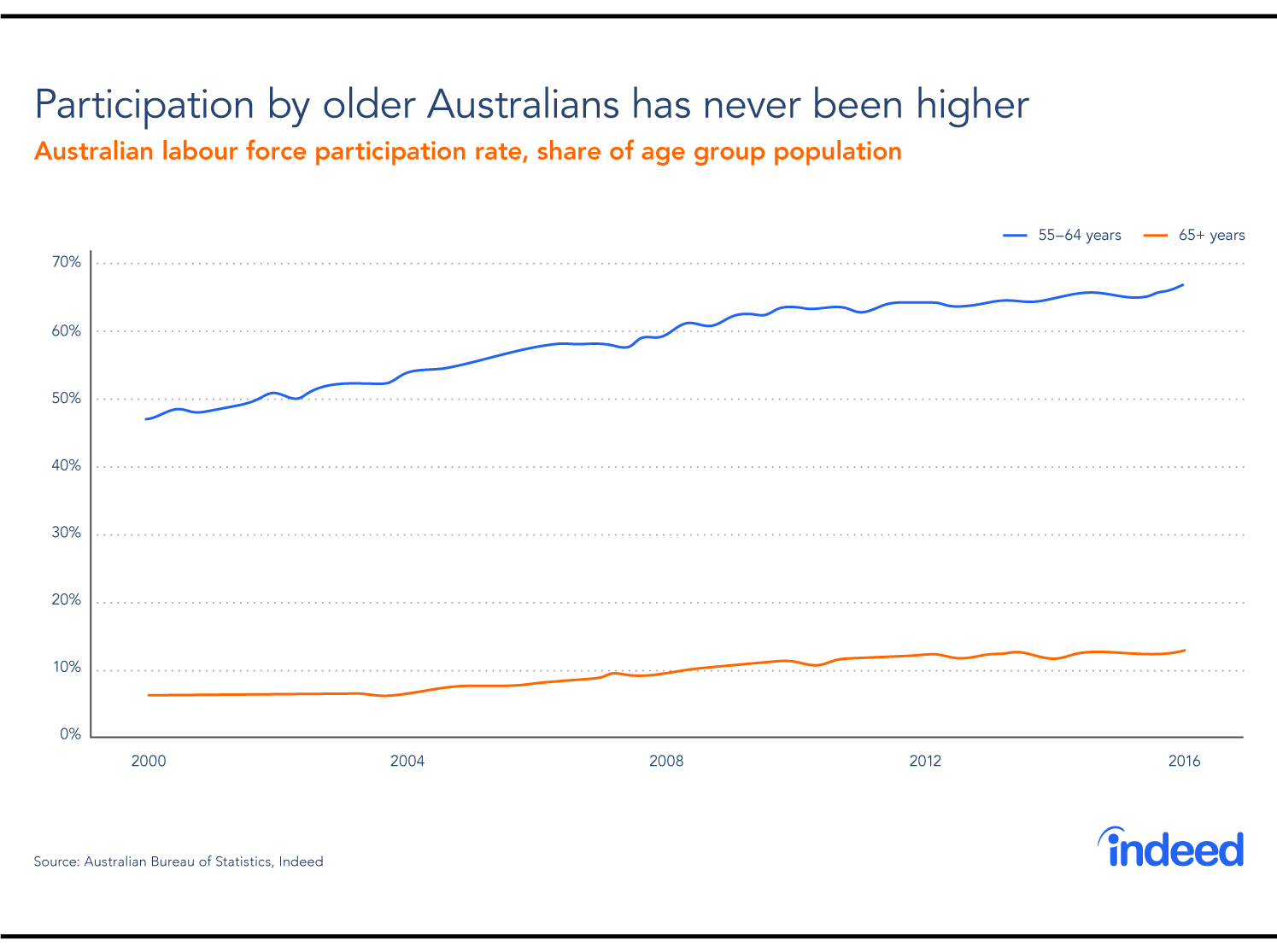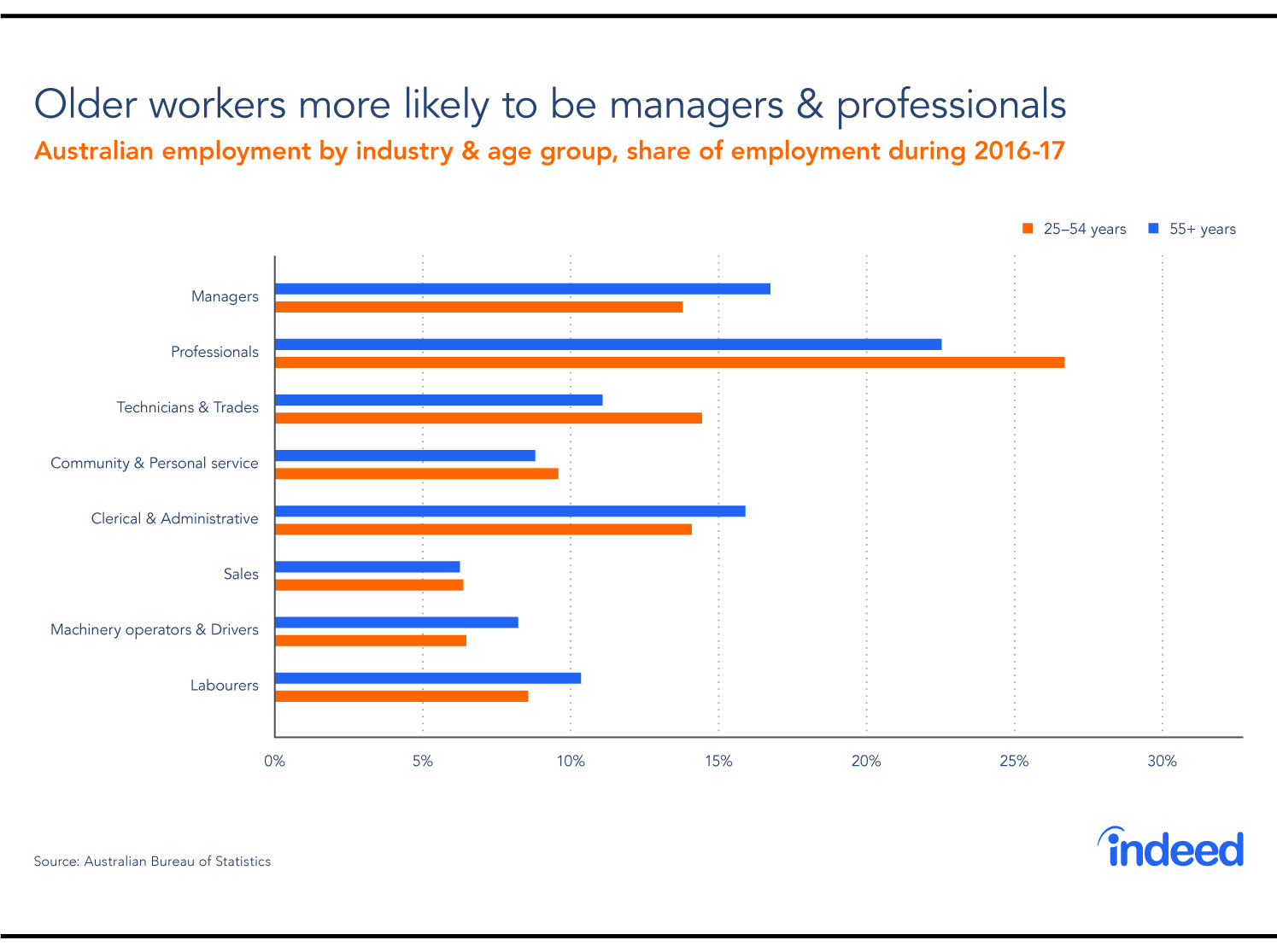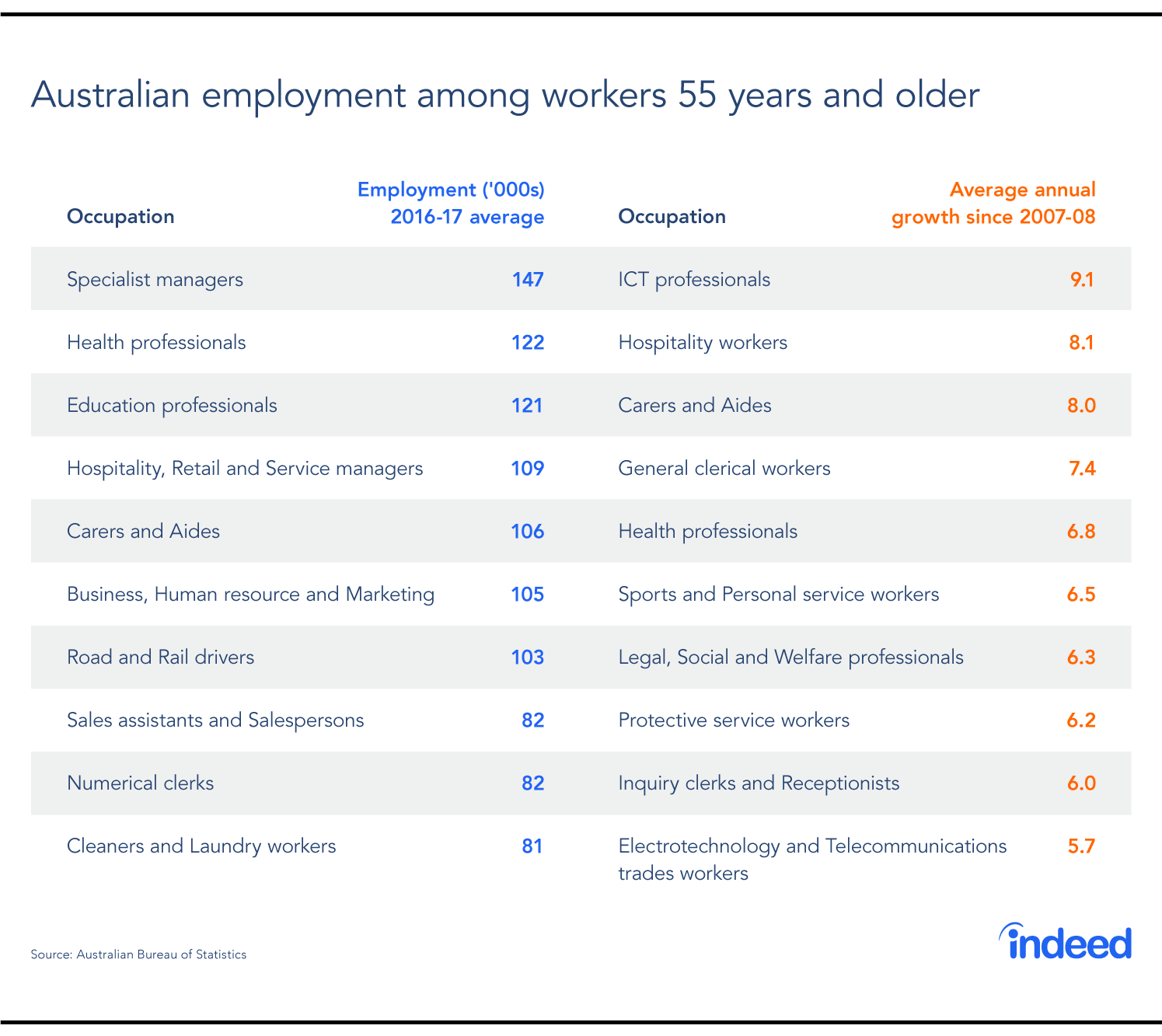Key points:
- Australia is getting older, putting downward pressure on the share of people in the labor force. But that trend is partly offset by rising numbers of older Australians who continue to work.
- People are continuing to work for a number of reasons, including improved health, more service sector jobs, and a need to boost superannuation.
- Older workers are concentrated in management and professional roles, but are also overrepresented in traditional blue collar occupations.
Australia’s population is getting older, putting downward pressure on economic growth and labour force participation—the proportion of the civilian adult population holding jobs or looking for work. But the drag on growth is moderated by the fact that older Australians are remaining in the workforce longer than previous generations.
In fact, labour force participation by people 55 and older has never been higher. And that’s helping offset the economic impact of an ageing population. What is more, older worker participation is expected to rise further in coming decades because of a gradual rise in the retirement age from 65½ currently to 67 by 2023.
For Australian businesses, the ageing labour force represents a challenge. Employers are responding by stepping up their hiring of older workers and keeping them on the job longer.
Among our findings:
- Improved health, more jobs in the service sector, favourable tax treatment of superannuation contributions and a rise in flexible work options have helped push the labour force participation rate of older Australians from 47% in early 2000 to 67% today.
- The lingering effect of the global financial crisis on superannuation savings has forced some older employees to work longer than they planned.
- Older Australians work in a two-tier economy: They are more likely to hold management jobs than their 25–54 year-old counterparts, but they’re also disproportionately working in labourer, clerical or driver roles.
- Economies around the world are confronting the burden of an ageing population, however, the impact both in Australia and across other advanced economies has been partially offset by the readiness of older workers to stay in the labour force.
Changing demographics drive economic growth
Australians are having fewer children and living longer. And, when we do have kids, we’re having them at an older age. In other words, the average worker in Australia today is different from his or her counterpart a generation ago. And that’s before you consider shifts in female labour force participation, immigration or changes in skill sets.
Almost 27% of Australia’s population is 55 or older, up from 24% in 2006 and 20% in 1996. The median age in Australia is currently 37, an increase of three years since 1996 and eight years since 1980. At the same time, the share of the population between 25 and 54—the years of greatest economic productivity—has fallen to its lowest level since 1987.

Changes this pronounced have strong effects on growth, income, and productivity, and they play a big role in determining how successful a nation’s economy may be. Australia is no exception.
Throughout the 1980s and 1990s, Australia enjoyed what Reserve Bank governor Philip Lowe has called a “demographic dividend.” It was a period when baby boomers were in their prime, and social and technological change encouraged many women to enter the workforce.
Employment growth was strong, the unemployment rate fell and labour force participation rose to historically high levels.
Over the past 15 years though, demographics have not been so kind to Australia. Since 2002, per capita real gross domestic product, a key measure of the economy’s overall performance, has grown at a tepid 1.2% annual pace, compared with average growth of 2.0% throughout the 1980s and 1990s. There are a number of reasons for the growth slowdown, including the global financial crisis that began about a decade ago. But one likely contributing factor has been Australia’s ageing population.
The hardest working generation of older Australians
Older workers are less likely to be in the labour force than younger workers due to retirement and other factors. As Australia’s population has aged, the economic effects have been noticeable, subtracting around 1.3 percentage points from Australia’s labour force participation rate since the 2007–08 financial year.
But the impact of an ageing population has been partially offset by the greater willingness of today’s older Australians to keep working compared with their counterparts in the past. For people between 55 and 64, participation has increased to 67%, from 47% in early 2000. And the trend is even more dramatic among those who have reached traditional retirement age—labour force participation by people 65 and over has more than doubled since 2000. The larger share of older workers remaining in the labour force has added around 1.1 percentage points to Australia’s participation rate.

Since the beginning of the global financial crisis, workers 55 and over have accounted for around half the increase in total hours worked in the Australian economy. They are working slightly fewer hours per person than previous generations of older workers but collectively, today’s older Australians are working harder than any previous generation in their age group.
Older Australians are staying on the job for a variety of reasons:
- Older Australians are healthier. We are living and staying healthy longer, and that has translated into longer, more productive careers.
- Changes in the type of work performed in Australia—including smaller shares of workers in construction, manufacturing and agriculture—have created more opportunities for older workers. The service sector, which now accounts for around 80% of Australian jobs, tends to be less physically intensive.
- Workplaces have become more open to flexible working arrangements. Workers are demanding greater flexibility and employers are obliging. Older workers are well placed to take advantage of these arrangements as they move toward retirement.
- The global financial crisis took a bite out of the superannuation savings of many Australians, forcing some older employees to work longer than they had planned. Australia’s baby boomers tend to be asset-rich, typically in residential property. But many are income-poor and their superannuation balances tend to be modest, limiting their retirement income.
- The superannuation system’s tax incentives encourage people to keep working. Salary sacrifice and voluntary contributions allow households to reduce their tax liability and prolong their superannuation payments.
One factor that hasn’t yet had an impact, but will push labour force participation higher in the future, is a rise in the age at which workers can access their superannuation, known as the preservation age. People born before July 1, 1960 can tap into their superannuation when they are 55. But those born after July 1, 1964 have to wait until they turn 60. With the retirement age also rising, it is probable that the preservation age will rise further in coming decades.
Finally, we don’t believe that businesses are employing older workers because there aren’t alternatives. While some skill shortages exist, which could create job opportunities for older workers, Australia doesn’t have an overall labour shortage. The nation’s population rose 1.5% in 2016—almost twice the growth rate in the US and the OECD, the organisation representing many of the world’s leading economies. And Australia’s measures of labour underutilisation remain elevated.
Older workers are concentrated in professional and management occupations
Older workers are most likely to be in professional occupations, with around 23% holding such jobs. Another 17% are in management positions, while almost 16% are in clerical or administrative roles.
At the same time, older workers disproportionately work as machinery operators and labourers, which are among the occupations that have experienced the weakest growth over the past decade. This overrepresentation may be because younger workers are better placed to change occupations or develop new skills.

Employment for older workers is also growing rapidly in nontraditional occupations. We wouldn’t necessarily expect ICT professional or hospitality to be growth opportunities for older workers, but their numbers in these occupations have increased 9% and 8% respectively since the 2007–08 financial year.

The ageing of Australia’s population has itself created opportunities for older workers. The number of older people working as carers and aides has climbed by an average of 8% a year since the 2007–08 financial year, and presumably much of that increase involves serving seniors. Growth in health professions has also been strong. In other words, older people caring for other older people may be one of Australia’s growth industries.
